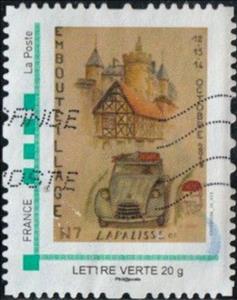Stamp: Festival Emboutillage Lapalisse (France 2019)
Festival Emboutillage Lapalisse (France 2019)
12 October (France ) within release Collectors : Montimbramoi. Miscellaneous goes into circulation Stamp Festival Emboutillage Lapalisse face value Prioritaire No Face Value
| Stamp Festival Emboutillage Lapalisse in catalogues | |
|---|---|
| Colnect codes: | Col: FR-MON 2019-167 |
Stamp is square format.
Procession of Vintage Cars of the 70s like 2Cvs|
Data entry completed
50%
|
|
|---|---|
| Stamp Festival Emboutillage Lapalisse in digits | |
| Country: | France |
| Date: | 2019-10-12 |
| Emission: | Personalized - Private |
| Format: | Stamp |
| Face Value: | Prioritaire No Face Value |
Stamp Festival Emboutillage Lapalisse it reflects the thematic directions:
A car is a wheeled, self-powered motor vehicle used for transportation and a product of the automotive industry. Most definitions of the term specify that cars are designed to run primarily on roads, to have seating for one to eight people, to typically have four wheels with tyres, and to be constructed principally for the transport of people rather than goods. The year 1886 is regarded as the birth year of the modern car. In that year, German inventor Karl Benz built the Benz Patent-Motorwagen. Cars did not become widely available until the early 20th century. One of the first cars that was accessible to the masses was the 1908 Model T, an American car manufactured by the Ford Motor Company. Cars were rapidly adopted in the United States of America, where they replaced animal-drawn carriages and carts, but took much longer to be accepted in Western Europe and other parts of the world.
A festival is an event celebrated by a community and centering on some characteristic aspect or aspects of that community and its religion or cultures. It is often marked as a local or national holiday, mela, or eid. A festival constitutes typical cases of glocalization, as well as the high culture-low culture interrelationship. Next to religion and folklore, a significant origin is agricultural. Food is such a vital resource that many festivals are associated with harvest time. Religious commemoration and thanksgiving for good harvests are blended in events that take place in autumn, such as Halloween in the northern hemisphere and Easter in the southern.
A house is a single-unit residential building. It may range in complexity from a rudimentary hut to a complex structure of wood, masonry, concrete or other material, outfitted with plumbing, electrical, and heating, ventilation, and air conditioning systems. Houses use a range of different roofing systems to keep precipitation such as rain from getting into the dwelling space. Houses generally have doors or locks to secure the dwelling space and protect its inhabitants and contents from burglars or other trespassers. Most conventional modern houses in Western cultures will contain one or more bedrooms and bathrooms, a kitchen or cooking area, and a living room. A house may have a separate dining room, or the eating area may be integrated into the kitchen or another room. Some large houses in North America have a recreation room. In traditional agriculture-oriented societies, domestic animals such as chickens or larger livestock (like cattle) may share part of the house with humans.



